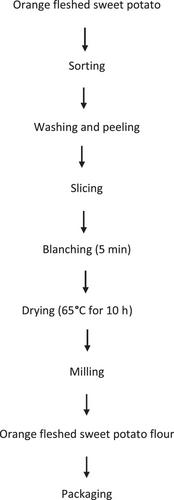Effect of orange-fleshed sweet potato (Ipomoea batatas)–Bambara groundnut (Vigna subterranea) composite flour on quality properties of pasta
Abstract
Non-wheat flours are gaining attention as substitutes for wheat flour, offering the potential to optimize local resource utilization and alleviate the demand for wheat. The study investigates the use of non-wheat flours, particularly a blend of orange-fleshed sweet potato (OFSP) (Ipomoea batatas) and Bambara groundnut (BG) (Vigna subterranean), as a partial replacement for wheat flour in pasta production. The aim is to improve the utilization of local resources, reduce the reliance on wheat, and enhance the nutritional quality of pasta. The production of OFSP and BG flour took place at Agricultural Research Council Roodeplaat Campus. The data were analyzed using analysis of variance, and significant means were separated using the Duncan multiple range test. The research found that pasta made from composite flour significantly influenced its composition and cooking characteristics when compared to 100% wheat pasta. The most nutritionally enriched pasta was achieved with a blend of 50% wheat, 25% OFSP, and 25% BG, featuring higher protein, ash, and fiber content. Consumers preferred pasta made from a composite flour of 70% wheat, 15% OFSP, and 15% BG. This research suggests the potential for producing pasta using OFSP and BG composite flour as a viable option.
Practical Application
The practical application of the research on orange-fleshed sweet potatoes–Bambara groundnut-based pasta has the potential to improve nutrition, stimulate local economies, enhance agricultural sustainability, and promote food security in regions where vitamin A deficiency is a concern and wheat importation is high.


 求助内容:
求助内容: 应助结果提醒方式:
应助结果提醒方式:


